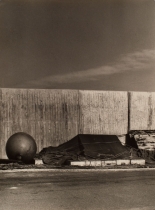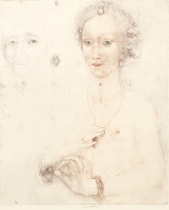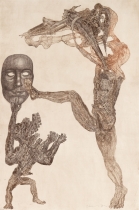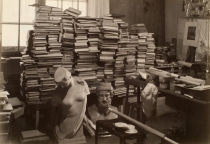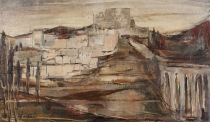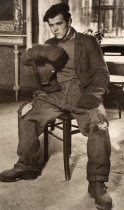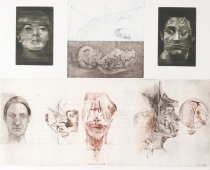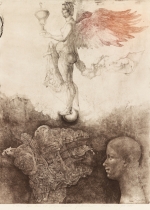Dealers without borders: a venerable Chicago gallerist reflects on life, and art, outside the lines
With the founding of Jacques Baruch Gallery in 1967, Anne Baruch and her late husband Jacques dedicated themselves to pioneering the contemporary art of Central and Eastern Europe in the United States. In the process, they braved the many challenges of going behind the Iron Curtain to introduce the works of such now-distinguished artists as Jiri Anderle, Jan Saudek, and Josef Sudek to American audiences.
I first met Anne – who closed her gallery in 1993 and is now a private dealer – through the artist Lucien Clergue. Lucien was formerly represented by Anne and is now with my gallery, FLATFILE. I remember his telling me, “You’re going to love her!” Sure enough, following our opening reception for Lucien’s retrospective in Fall 2003, Anne and I found ourselves sitting across from each other at dinner, and wound up laughing until we cried. We’ve been friends ever since. The following conversation took place at Anne’s home and gallery in January 2004.
– Susan Aurinko
Anne, what possessed you to open a gallery?
(laughs) It becomes possession! Back in 1967, my husband Jacques decided he was tired of architecture, because it had become only a means of making money rather than accommodating the need of the individual. He had been trained as an artist in Poland, as well as an architect, and was a survivor of the Holocaust. The desire to help him make life positive was always with me, so when he wanted to open a gallery, I thought it would be a good idea. We both had artistic backgrounds – as a young person I’d had scholarships to the School of the Art Institute – and we’d always followed what was going on in art. So Jacques went to the nine or 10 galleries that existed in Chicago at that time, and asked the owners what it took to have a good gallery. Most of them advised that if you weren’t married to a millionaire, and you weren’t a millionaire yourself, you should divorce your wife and marry a millionaire – because it’s a very expensive business to be in! Of course, we took that lightly, and decided to go ahead. Then we needed to decide our focus, because at that time Op Art and Pop Art were very popular; that was the type of art being shown everywhere. As a person familiar with the art in Eastern and Central Europe, Jacques knew there was always a group of wonderful artists in each country, and felt perhaps we should focus on art from that part of the world. Of course, at that time, it was behind the Iron Curtain. No information was coming out, so we had no idea who the artists were, where they were, or what the situation was like there. We only knew that they were under Communist domination. Anyway, the first trip over there was Jacques’ alone, because he had not been home for 23 years – he hadn’t been able to get a visa. So he went by himself, to try to find out what had happened to other members of his family and friends. Then, a few months later, I went with him, and we discovered that life under Communism was horrible. There was no material for the artists to work with; they were using everything they could find. Even if you wanted to do something officially with the government – which was the only way you’d be able to get paintings out – it was very difficult, because the offices of government had shortages of everything as well. If they had typewriters, they didn’t have paper. So it took about a year, once we had chosen the artists, to be able to get the work.
With such a dearth of information about Communist Europe at the time, how did you even begin to search out artists over there?
We started in Poland, because that was Jacques’ home. The work was interesting and very good, but we decided we would expand our opportunities and knowledge by going other places. So the next year, in 1968, we went to Czechoslovakia. We were very fortunate, because we arrived in July at the height of the Prague Spring, and any place you looked, there was an exhibition of art. Before then, showing art had not been permitted, but during Dubcek’s era – he was President of the country at that time – he wanted to put a “friendly face” on Communism. So he was opening the Iron Curtain, and letting people travel. And this particular Spring, they had exhibitions in every museum, every empty space, on the street – any place they could find. As a result, we had an exposure, at that time, which was unheard of in any period of history. We had the opportunity to meet the artists, go to their studios, make our selections, go to all these exhibitions. We met the poets, we met the writers, we met the filmmakers, we met the photographers – we met everyone.
So it was a case of being in the right place at the right time.
Or so we thought. We were supposed to work through this government agency, and the people there were very helpful; they would take us around, they would drive us. We had exhibitions arranged for about five years in advance, and everybody was very excited. The artists were excited because they would have the possibility of being seen, and we were excited by what we found. The work was incredible, because in that world, what happened was: you couldn’t be seen, so you stayed in your studio and you worked. It was art for art’s sake, not for commercial gain. The artists didn’t know anything about what’s in, what’s out, what’s up, what’s down, what’s hot, what’s not. They just concentrated on what they were doing, whether they were being shown or not, and their studios were filled. It was very, very exciting. Anyway, we had all these arrangements made, and then we were informed by Swissair that our flight was going to be leaving a day in advance. We knew we had to go – during Communist times, only Swissair and Lufthansa were permitted to fly into Czechoslovakia, so if you missed a flight you’d have to wait a week. In the meantime, we had a visit from a Polish artist and her husband, who was a Polish correspondent for the Swedish newspapers. He told us he’d been advised before he came to Prague to leave immediately, because the Czechs would puncture his tires; they didn’t like the Poles. But he said that wasn’t it – there was something else in the air in Poland. And when he came to Czechoslovakia and went to the Polish embassy, he sensed an attitude, an atmosphere, that was very, very difficult. So he said, “If I were you, I’d leave early.” We told him we were forced to leave early anyhow. And when we awakened the next morning in Switzerland, the Russians and the other satellite countries had invaded Czechoslovakia.
Suddenly, everything we did, everything we’d planned, was in doubt – even though we’d bought a lot of art, we weren’t sure we’d be able to retrieve it. It took many, many months of writing and chasing to get it – and we never heard a word from the artists. Eventually we got most of the work, but not all of it. We were also informed that we could not count on getting any more shows, because the world had changed.
How was the work received here when you established the gallery?
It was received well. But also, people we thought were our friends just disappeared. They didn’t want to be associated with Communists – which they assumed we were.
Where was the gallery at that time?
At 154 East Superior, where Neiman Marcus is now. Less than a year later, we had to get out of there, because they were tearing the building down.
For Neiman Marcus!
Actually, for a parking lot.
So after a few moves, you ended up at 900 North Michigan. Tell us about that space.
The space was the architect’s apartment, and it was remarkable, as the whole building was. There were 14th-century galley doors from ships, and 17th-century doors from what were probably chapels, because they had the 12 apostles on them. The front doors were probably 16th-century, and were just exquisite. The walls were stone, the ceiling was 30 feet high, there were balconies overlooking the space – it really looked like one big, empty courtyard. Jacques looked it over, and being an architect, said, “Oh, this will be fantastic!” And it was very inexpensive; it was about 6,000 square feet, and I think it was $600 a month. So we rented it, and Jacques set up walls so we would have more places to hang the works. It turned out to be a very extraordinary space.
When did you open there?
We opened in September of 1970, but in the meantime, Jacques had a massive heart attack and was in the hospital. So everybody we knew was coming out to help finish off the gallery – we had people from the brokerage world, the legal world, the medical world, students. Everyone was determined that the space was going to open when it was supposed to open, and it did. And Jacques came from coronary intensive care to the opening! How do you like that?
That’s unbelievable.
But the whole event was incredible. The opening brought in many, many people, because the space was extraordinary, and also because the first exhibition was from Yugoslavia, and people had no idea what to expect. We had drawings, tapestries, painting, and sculpture, and it was marvelous work. People couldn’t believe that this was going on in that part of the world. And the place was so crowded you couldn’t walk in or out. We had a two-story staircase, and nobody could go up or down. So the show was a great success, and it was really the beginning of what became the Jacques Baruch Gallery, and the special work we brought in.
How did the other galleries receive you?
Well, there weren’t a lot of galleries at that time, so it wasn’t a competitive world. Phyllis Kind had just started her gallery, showing the Chicago Imagists. Bud Holland had his own gallery, with its own taste. Richard Gray was open on Michigan, and Marianne Deson was partnered with Sonia Zaks at that time. But everybody was doing something different. We did have a gallery association – I think there were 12 of us or so – and when we got together there was great camaraderie. It was really wonderful. Everybody was pretty cooperative; they were all good people, all very dedicated and serious. It was just a very interesting time in all the galleries. But it was always a tremendous amount of work, because if you’re serious, you’re going to be working your tail off. You can’t help it.
No question. I think the business we’ve both chosen to be in is very risky, on a lot of levels. Certainly it’s a financial risk, and for me, starting out at 49, it was also an emotional risk. I wanted to fill a need I saw here to show emerging artists, but I was worried it might not fly, and that I would leave the artists even more depleted and disappointed than they were in the first place. But unlike most of us, you’ve taken physical risks, as well, in order to bring these works to your collectors.
I was one of those fortunate people, as was Jacques, who really have a deep love and care about the arts of all types. And when you develop a passion in the arts, no matter what happens or what difficulties you encounter, I do believe you take risks you would not normally take. When we decided to work behind the Iron Curtain, we really weren’t sure what we were getting ourselves into. If we had intellectually involved ourselves in what the risks might be, perhaps we wouldn’t have done it. But there weren’t any other people we could speak to who had any experience in that part of the world. As I said, once the Communists took over again, we didn’t know whether we’d be able to get work out. About six months after the invasion, we went back to the Czech Republic just to talk to the artists, and try to find out what was actually going on. And these people were devastated. Their world was bad before, but they had a breath of fresh air for a short period of time, and then the Iron Curtain slammed down again. The atmosphere in the area was horrible; everybody was depressed, and certain that they would never climb out of their jail. The artists were sure they’d never be seen again. It was also a period when Jacques could no longer travel, because he’d had open-heart surgery and was not in very good condition. So I had to take the risk individually, as a female going to a very chauvinistic part of the world, and during the time of the Cold War. You couldn’t help but have trepidation, because you didn’t know what the end result was going to be. The artists continued to work, I must say. It was overwhelming to see them putting in 18-hour days without any knowledge of whether their work would ever be seen. So I tried to figure out how we could continue to help them – and it wasn’t just about my part of it. Would the artists also be willing to take a chance? Because even though I paid them for the work, the work was not only valuable financially. It was part of a heart, a mind, eyes, hands – it was part of their being. So for them, if anything happened to it, it would be like losing their child. Every little part of the work was important; everything had meaning.
For about the next 20 years, though, you continued to bring work out of Czechoslovakia, Poland, Yugoslavia, and Hungary. How did you manage to get the work back to the United States?
Well, at the beginning, we decided we would try with works on paper, because it would be impossible to roll up a big canvas, or take a sculpture, and try to carry it out undetected. One of my methods was to bring portfolios filled with posters and junk art, nothing worthwhile. The guards would open these parcels at the border and go through them, and then they would tie them up with string and wax, which they imprinted with a seal so the package couldn’t be tampered with. But they forgot that artists know how to do all these things! They can use their hands and figure out how to make a little wax impression. So once we’d gotten the approvals, we would take the junk out, replace it with good works, and then the artists would remake all the seals. Another difficulty was, you could not let one artist know the other artists you were working with. I would bring lists of our exhibitions to show them all the things we were doing, and I would have to code them by dots, because in that type of atmosphere, you never knew who might report someone. You were treading on very difficult territory. It was dangerous – and expensive, because we paid for everything up front, and there wasn’t a possibility of returning the work. The artists established the prices, and if I thought they were too cheap I would pay them more. But we felt it was worth it, because the artists were so good that they had to be seen. And that feeling has been verified many, many times over. After 1987, our government and the Czech government signed a cultural agreement, which meant their government would now be helpful to me in acquiring works there. That made things somewhat easier, but there were still certain artists who weren’t permitted to be registered, and I’d have to bring them materials because they couldn’t get them themselves. So it was always a risk, and it was always difficult – but it was always worthwhile. I still love the art, and I still love the people who created it.
One of the things we have in common is that we’ve both committed ourselves to introducing new artists, and taking on the educational component that comes with that. What were some of the challenges you found in trying to build an audience for this work?
It was never easy, but no gallery business is ever easy unless you only show big names. If you’re introducing artists all the time, it’s a much more difficult world to explore, because people need to have confidence in whom they’re buying.
Collectors do need certainty, of some kind. They ask, “What will this be worth in five years?” And my philosophy of collecting is very much like yours: if you love it, and it speaks to you, it belongs with you.
That’s right, and you’ll never tire of it. But the art business is different from any other business in the world. As dealers, we’re putting up something that touches us, and we just hope it will touch somebody else. A work of art is not an object – it really isn’t. You know, if you buy shoes, you can exchange them. But art must fit the eyes, the heart, and the head – and then, hopefully, the hand that goes into the pocket. Ultimately, the dealer doesn’t sell the work; the work sells itself, to that particular individual who responds to it. And if something captures a person’s imagination, they’ll gravitate toward it, even if they’ve never heard of the artist. Certainly, you have to be ready to help people understand a little bit of what they’re looking at.
But there are times when a dealer has to say, “Only the artist understands it. I can’t explain it because I didn’t do it, and I can only tell you what my feeling is, which may be totally different from your experience.” I always tell people that what I see is not nearly as important as what they see. I never forgot this one woman who said to me, “I don’t like your art!” And I replied, “Nobody said you had to!” Just because you come in and look around doesn’t mean there’s a rule or a law that you have to like it. But she was so adamant.
What was it that she didn’t like?
Well, a lot of it wasn’t pretty enough. Over the years, we put up a lot of very troubling pieces. But we felt that was important, because there were so many things going on in the world, and people had to be aware of them. People here had no idea what life was like under Communism – only what they read in the newspapers. We wanted them to know how tough it was for anybody in any of the creative areas, but that despite the difficulties, the art never stopped. The same thing happened in China during the Cultural Revolution – people would play with imaginary violins, or they would hold the violin and not make a sound. Everything had to be hidden. I do think we have to learn to appreciate how fortunate we are in this country, in comparison to other places in the world. Even though it’s difficult for galleries, and difficult for artists, we have 10 times more opportunities.
Political art is very hard to sell, though, because it doesn’t look good over the sofa. Our show this May will be extremely controversial, and I love that we’re doing it, but it’s not a show that will sell.
But you don’t know that. We showed a series by one of the artists called Illusion and Reality, and we called it the “Soldier Series” so people would have some idea what it was. There were horrific paintings, drawings, and prints, and it was all about war. Yet there are many people who have those works in their homes now, and many museums have them in their collections. We felt strongly that powerful works, which have meaning to people, should be seen – not just the art that would sell. The public needs to know that there are all kinds of art out there. And people respond to it, even if they’ve had no experience with the subject matter. I commissioned a work that Jacques didn’t know about, called Cruel Game for a Man, by Jiri Anderle. It was an extremely powerful piece, and Harold Joachim, who was curator of prints and drawings at the Art Institute, wrote in Art News that it was probably the most important work of the decade. The image was of Hitler, and bodies, and a tormented world. It was very beautiful, in addition to its horror; it was a wonderful work. We had an edition of 70, and they sold out. And these were collectors from every age group – young couples all the way to old people. Look, your German Expressionists are very powerful, and people hang them all the time! And many of those works are very, very painful. But whatever it is that captivates us is something we can’t explain. Maybe it’s not something you’re going to put over your couch. But you might put it in your den, or your office – or in your closet, just because you wanted it, and you needed to have it.
Given the level of personal risk both you and your artists were taking, your role went above and beyond that of a typical dealer. But after all your years of experience in this business, what would you consider the ideal gallery/artist relationship to be?
Well, when an artist works with a gallery, it really becomes a partnership.
Absolutely; it’s a marriage. And sometimes there’s a divorce!
(laughs) How true! But if it’s going to be a truly in-depth relationship, where you know you’re going to work together for years, you need an artist who has reached a certain maturity. You need to know they’re going to stay with the art – and not every young artist does, because it’s a tough world. And if they change their work radically from month to month, there isn’t enough stability for the dealer to be able to cultivate an audience. The ideal situation is when you come to know each other very well, and when, during the tough times, you’re able to help the artist by giving them advances of some kind, and to make them feel that you really care about them and their work. And dealers should try – as we did – to arrange exhibitions everywhere. We worked with galleries and museums and institutions all over the country – any regular place of business or the arts – that wanted to show our artists. Now, artists should also understand that, as dealers, we never made any money on this. But we didn’t expect anything in return, as long as we could elevate the reputation of the artist.
And that is what you get in return. Any time my artists are out in the world, our gallery is getting exposure as well.
It’s true. But our world was totally different. Everything that happened to and for an artist had to originate from us, because given where the artists lived, it wasn’t possible for them to go and find other galleries. But I think it’s very important that a dealer be involved with the artist, and not have so many artists that you can’t do well for any of them. You need to be able to work for a dedicated number of people you really believe in, who will have some success. To me, a good dealer understands that you’re going to have to make sacrifices, unless you show big names that everybody knows. When you’re showing new or emerging artists, you have to put the energy, the effort, the care – and the money – in. You don’t just take the artist’s work and put it in a drawer. I feel that artists who are fortunate enough to get a dedicated dealer will never understand the work that dealer has to do in order to help bring them into the limelight – even if it’s a small, one-lamp limelight, because only about 25 artists in the world become known. The rest might develop reputations; they may be able to teach in universities, or find other ways to make a living. But there are never sufficient galleries to take care of all the artists who are out there.
Chicago has 150 galleries now, yet I still get 10-20 portfolios a week from artists who have never been shown anywhere. A lot of them are really amazing, but I can’t take them all.
No, it’s not humanly possible. And I think artists have to expand their own vision and approach galleries in other places, because there’s a limit – there are only 12 months in a year, and if the shows are too short, nobody benefits from them. Nobody gets to know the artist, either. I think one of the big problems today is that everyone can go to art school, and because of that more artists are produced than ever before. Now where are they going to find outlets? They can’t expect other people to form art galleries, and invest tremendous amounts of money, in order to show them. And just because you go to art school, that doesn’t make you into a great artist. I think we don’t take art seriously enough in our country. It truly is a real profession, and it’s not to be taken lightly, in that you just go to art school because you don’t know what else to do. In other countries there are many fewer art schools, and not everybody can go. Not everybody can afford it, for one thing. But you also have to have a very good portfolio to present by the time you’re 12 or 14! You have to show evidence of talent at a very early age. This is a profession that goes back centuries, and people who go into the art schools should really be only the most talented. Now maybe that sounds elitist, but what are the rest of the people going to do with their world? In Europe, students learn to do many things besides fine art – like book illustration or graphic design – because otherwise it’s very difficult to make a living. Here, you’re more likely to become a waitress. But you’re really better off illustrating a book, because that way, you still keep your hand in art. Even if you’re not the greatest fine-art artist, there’s always wonderful work to be done. There’s a poster museum in Poland, for example, that has beautiful things. There are so many worlds where you can use your art in a very constructive way, and it doesn’t necessarily have to be in a gallery. There aren’t ever going to be enough galleries to support and help all the artists who are out there, and the artists have to know that.
I began FLATFILE as a photography gallery, and one of the things I always encouraged my artists to do was not work as a waitress, but to work in a photo lab or a darkroom, or take wedding pictures. Do whatever you need to do to stay within the field of photography and keep the money coming in, because there is nothing you’ll do with a camera in your hand that will not make your fine-art work stronger. Your printing gets better; your eye becomes more refined. We work with students from the School of the Art Institute and Columbia College, and my observation from that is: SAIC turns out artists, while Columbia turns out working artists. I’ve found the Columbia students are more successful as interns, because they’re very willing to learn the practical aspects of both creating, and dealing with, art. By contrast, the SAIC students think of themselves as “artists” – which is way too elitist. Those are the people who end up waiting tables, I think, because they don’t know other ways of working in the arts.
I think, more than anything else, art students should request to have different dealers and curators come in and talk to them about the realistic field of art. Not to romanticize it or make it elitist, but to make it into the actuality.
You’re so right. There is a reality, and there’s something else. And that bubble, that dream that people have when they go into art school, has nothing at all to do with the real world – the gallery world, the museum world. It’s in somebody’s daydreams.
Which brings up another thing I’ve heard from artists: that Chicago is just a stepping-stone. For as long as I can remember, and that’s a long time, it has been said that Chicago’s a “second city” in art, and that artists have to go to New York – and nowadays to California, as well – in order to find a reputation. But it’s not true. Each locale, whether you’re in a farm town, a big city in America, or a big city in Europe, produces different art. And this town has produced many, many fine artists; some of the best literature, music, and theater have come out of Chicago. So this is not a city that represents any “second” of anything. Chicago is Chicago. It has always had its own way of doing things, its own way of dealing with problems. And it has always been a great, fruitful place for creativity. We’ve had so much going on here, and if that doesn’t inspire the artist, then do move! Chicago’s a very special town – it’s powerful, it’s tough, and it’s beautiful. If artists feel they can’t make it here, I don’t think they’re going to make it in other places, either.
I agree. Chicago is a small pond in which you might become a big fish. If you leave here and go to New York, you’re worse than a minnow in the ocean, quite often. So when I have artists who say, “OK, I’ve been doing really well in your gallery and selling a lot; now I’m ready to go to New York,” my question is always, “Why?” There are other places you can do well. Why does everyone seem to think that the natural second step is New York?
I can understand a certain amount of it. There are so many more museums, galleries, and other artistic outlets in New York that people think they’ll go there and have immediate success. But it doesn’t work that way. Such incredible competition goes on there that doesn’t exist here. If you do think you’re good enough, you should wait until you achieve real maturity before you move your body and your work to New York, because they’re even more critical than we are in Chicago. And they have many more people approaching them. I think New York is fabulous – I love it – but I think Chicago has everything to offer any artist, and if you’re not successful here you sure won’t be successful there. That’s the way it works.
In a lot of cases, I think these notions of Chicago as provincial, or a second city, are excuses for people to use. As you put it once in conversation, it’s a “sour grapes” kind of thing: “I couldn’t make it here because my work is so conceptual that Chicago just doesn’t know how to handle it.” I don’t think that’s true; it’s more like the work isn’t good enough for Chicago. So what are you doing going somewhere beyond Chicago, and thinking you can climb the ladder there?
Artists always have to realize that collectors are everywhere. When work is shown in Chicago, it doesn’t necessarily mean a Chicagoan is buying the art. In all these years of being in business, I’ve realized the best time for people to buy art is when they’re away, out of their own city. When they have a moment to relax, and they don’t have to rush home or off to work, they will go to a gallery if they’re interested in art. So in the end, it doesn’t make any difference where anyone lives.
None at all. My two biggest collectors are in Alabama and Nebraska, in the middle of nowhere. You can’t say these people are very urban, although some of the work they’re buying is incredibly urban. But people who have good taste, and know art, can be living anywhere.
That’s something else the dealer tries to help the artists understand: there’s no explaining why one artist will sell so well, and another – who is of equal quality but makes different imagery – will not. There are so many different ways people collect. Some people only collect work that appears in a book.
Yes, that’s very common.
And some people will only collect if the work is purely abstract...or if the image has a cat in it!
I had some photography collectors come in from Art Chicago three years ago, when I first opened, and they must have pulled out 40 photographs. Eventually they narrowed it down to about seven images – and as it turned out, they all had windows in them. So I said, “Oh, you collect images of windows!” And they said, “No...we just like these.” It was so funny; they hadn’t even realized what was attracting them to the images, and we were the first to see it. So you don’t know what moves people – and often they don’t know themselves.
But it’s something that becomes part of their emotional experience, and I think it’s very exciting when that match happens between a collector and a piece of art.
When the art speaks to you in a soft voice only you can hear.
That’s a very beautiful way of expressing it.
And to watch it happen is like watching someone fall in love. It’s quite marvelous.
Anne Baruch interviewed by Susan Aurinko
Mouth to Mouth magazine, Chicago
Spring/Summer 2004


